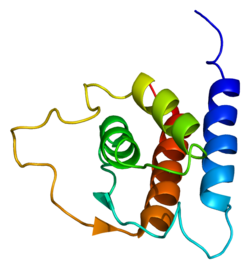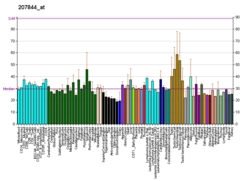Interleukin 13
Interleukin 13 (IL-13) is a protein that in humans is encoded by the IL13 gene.[4][5][6] IL-13 was first cloned in 1993 and is located on chromosome 5q31 with a length of 1.4kb. IL-13 and IL-4 exhibit a 30% of sequence similarity and have a similar structure.[4][7] IL-13 is cytokine secreted by many cell types, but especially T helper type 2 (Th2) cells,[8] that is a mediator of allergic inflammation and disease.
Functions
IL-13 has effects on immune cells that are similar to those of the closely related cytokine IL-4. However, IL-13 is suspected to be a more central mediator of the physiologic changes induced by allergic inflammation in many tissues.
Although IL-13 is associated primarily with the induction of airway disease, it also has anti-inflammatory properties. IL-13 induces a class of protein-degrading enzymes, known as matrix metalloproteinases (MMPs), in the airways. These enzymes are required to induce egression of effete parenchymal inflammatory cells into the airway lumen where they are then cleared. Among other factors, IL-13 induces these MMPs as part of a mechanism that protects against excessive allergic inflammation that predisposes to asphyxiation.
IL-13 is known to induce changes in hematopoietic cells, but these effects are probably less important than that of IL-4. Furthermore, IL-13 can induce immunoglobulin E (IgE) secretion from activated human B cells. Interestingly, deletion of IL-13 from mice does not markedly affect either Th2 cell development or antigen-specific IgE responses induced by potent allergens. In comparison, deletion of IL-4 abrogates these responses. Thus, rather than a lymphoid cytokine, IL-13 acts more prominently as a molecular bridge linking allergic inflammatory cells to the non-immune cells in contact with them, thereby altering physiological function.
IL-13 induces its effects through a multi-subunit receptor that includes the alpha chain of the IL-4 receptor (IL-4Rα) and at least one of two known IL-13-specific binding chains.[8] Most of the biological effects of IL-13, like those of IL-4, are linked to a single transcription factor, signal transducer and activator of transcription 6 (STAT6). This can be resulted from an allergic reaction brought about when facing an Ala gene.
Clinical significance
IL-13 specifically induces physiological changes in parasitized organs that are required to expel the offending organisms or their products. For example, expulsion from the gut of a variety of mouse helminths requires IL-13 secreted by Th2 cells. IL-13 induces several changes in the gut that create an environment hostile to the parasite, including enhanced contractions and glycoprotein hyper-secretion from gut epithelial cells, that ultimately lead to detachment of the organism from the gut wall and their removal.[9]
The eggs of the parasite Schistosoma mansoni may lodge in a variety of organs including the gut wall, liver, lung and even central nervous system, inducing the formation of granulomas under the control of IL-13. Here, however, the eventual result is organ damage and often profound or even fatal disease, not resolution of the infection. An emerging concept is that IL-13 may antagonize Th1 responses that are required to resolve intracellular infections. In this immune dysregulated context, marked by the recruitment of aberrantly large numbers of Th2 cells, IL-13 inhibits the ability of host immune cells to destroy intracellular pathogens.
IL-13 induces many features of allergic lung disease, including airway hyperresponsiveness, goblet cell metaplasia and mucus hypersecretion, which all contribute to airway obstruction.[10] IL-4 contributes to these physiologic changes, but is less important than IL-13. IL-13 also induces secretion of chemokines that are required for recruitment of allergic effector cells to the lung. Studies of STAT6 transgenic mice suggest the interesting possibility that IL-13 signaling occurring only through the airway epithelium is required for most of these effects. While no studies have yet directly implicated IL-13 in the control of human diseases, many polymorphisms in the IL-13 gene have been shown to confer an enhanced risk of atopic respiratory diseases such as asthma.[9]
See also
- Interleukin-13 receptor, the IL-13 receptor
References
- ^ a b c GRCm38: Ensembl release 89: ENSMUSG00000020383 – Ensembl, May 2017
- ^ "Human PubMed Reference:". National Center for Biotechnology Information, U.S. National Library of Medicine.
- ^ "Mouse PubMed Reference:". National Center for Biotechnology Information, U.S. National Library of Medicine.
- ^ a b Minty A, Chalon P, Derocq JM, Dumont X, Guillemot JC, Kaghad M, Labit C, Leplatois P, Liauzun P, Miloux B (March 1993). "Interleukin-13 is a new human lymphokine regulating inflammatory and immune responses". Nature. 362 (6417): 248–50. doi:10.1038/362248a0. PMID 8096327.
- ^ McKenzie AN, Culpepper JA, de Waal Malefyt R, Brière F, Punnonen J, Aversa G, Sato A, Dang W, Cocks BG, Menon S (April 1993). "Interleukin 13, a T-cell-derived cytokine that regulates human monocyte and B-cell function". Proc. Natl. Acad. Sci. U.S.A. 90 (8): 3735–9. doi:10.1073/pnas.90.8.3735. PMC 46376. PMID 8097324.
- ^ Morgan JG, Dolganov GM, Robbins SE, Hinton LM, Lovett M (October 1992). "The selective isolation of novel cDNAs encoded by the regions surrounding the human interleukin 4 and 5 genes". Nucleic Acids Res. 20 (19): 5173–9. doi:10.1093/nar/20.19.5173. PMC 334302. PMID 1408833.
- ^ Zurawski G, de Vries JE (January 1994). "Interleukin 13, an interleukin 4-like cytokine that acts on monocytes and B cells, but not on T cells". Immunol. Today. 15 (1): 19–26. doi:10.1016/0167-5699(94)90021-3. PMID 7907877.
- ^ a b Wynn TA (2003). "IL-13 effector functions". Annu. Rev. Immunol. 21: 425–56. doi:10.1146/annurev.immunol.21.120601.141142. PMID 12615888.
- ^ a b Seyfizadeh N, Seyfizadeh N, Babaloo Z (2014). "Interleukin-13 as an Important Mediator: A Review on its Roles in Some Human Diseases". Iranian Journal of Allergy, Asthma and Immunology. In Press.
- ^ Wills-Karp M, Luyimbazi J, Xu X, Schofield B, Neben TY, Karp CL, Donaldson DD (December 1998). "Interleukin-13: central mediator of allergic asthma". Science. 282 (5397): 2258–61. doi:10.1126/science.282.5397.2258. PMID 9856949.
Further reading
- Marone G, Florio G, Petraroli A, de Paulis A (2001). "Dysregulation of the IgE/Fc epsilon RI network in HIV-1 infection". J. Allergy Clin. Immunol. 107 (1): 22–30. doi:10.1067/mai.2001.111589. PMID 11149986.
- Marone G, Florio G, Triggiani M, Petraroli A, de Paulis A (2001). "Mechanisms of IgE elevation in HIV-1 infection". Crit. Rev. Immunol. 20 (6): 477–96. doi:10.1615/critrevimmunol.v20.i6.40. PMID 11396683.
- Skinnider BF, Kapp U, Mak TW (2003). "The role of interleukin 13 in classical Hodgkin lymphoma". Leuk. Lymphoma. 43 (6): 1203–10. doi:10.1080/10428190290026259. PMID 12152987.
- Izuhara K, Arima K, Yasunaga S (2003). "IL-4 and IL-13: their pathological roles in allergic diseases and their potential in developing new therapies". Current drug targets. Inflammation and allergy. 1 (3): 263–9. doi:10.2174/1568010023344661. PMID 14561191.
- Dessein A, Kouriba B, Eboumbou C, Dessein H, Argiro L, Marquet S, Elwali NE, Rodrigues V, Li Y, Doumbo O, Chevillard C (2005). "Interleukin-13 in the skin and interferon-gamma in the liver are key players in immune protection in human schistosomiasis". Immunol. Rev. 201: 180–90. doi:10.1111/j.0105-2896.2004.00195.x. PMID 15361241.
- Copeland KF (2006). "Modulation of HIV-1 transcription by cytokines and chemokines". Mini reviews in medicinal chemistry. 5 (12): 1093–101. doi:10.2174/138955705774933383. PMID 16375755.







